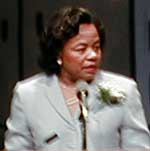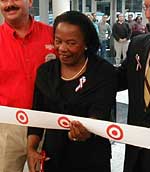By Dan Olson
Minnesota Public Radio
November 7, 2001
|
| RealAudio |
R.T. Rybak's mayoral victory in Minneapolis Tuesday marks the end of Sharon Sayles Belton's eight years in office. She was the first black and the first woman elected mayor in Minneapolis when she won the office in 1993. She leaves her post in January as the city's crime rate is at it's lowest point in decades, and downtown development is at a peak. Her friends and coworkers say the achievements are part of her legacy.
| |
|
|
|
||
Her friend and political mentor, Harry Davis, says Sharon Sayles Belton started her first term as mayor facing big problems.
"She came in at a very tough time, because crime was running rampant," Davis says.
In 1993, this country's crack cocaine epidemic was raging in Minneapolis. The murder rate was at an all-time high. Drug dealers operated openly on street corners.
Sayles Belton and the city council selected a police chief, Robert Olson, willing to try a controversial policing strategy. Patrols were targeted to high crime areas, often poor neighborhoods with high minority populations. Residents charged the police with racial profiling.
Former Minneapolis Mayor Don Fraser, a fellow Democrat and a Sayles Belton supporter, says having an African-American as mayor helped.
"I think the mayor was able to help manage those perceptions and keep the police department on track during this period," says Fraser.
Federal taxpayer dollars paid some of the higher law enforcement expenses, but leaders had to find a lot of money in the city budget to cover costs. Minneapolis City Coordinator Kathleen O'Brien says Sayles Belton, a former city council member, understood the intricacies of the city's complicated budget.
"There's been a major reallocation of dollars from the departments throughout the city to public safety, to meet the challenge of crime in Minneapolis," O'Brien says.
Race relations were strained again when Minneapolis demolished public housing on the city's north side. The demolition was part of the Hollman Decree, the lawsuit settlement which charged the city and the federal government with a pattern of housing discrimination. The outcome is a controversial plan to build hundreds of units of new public housing - and market rate units - in an unprecedented development project in one of the city's historically black neighborhoods.
| |
|
|
|
||
Downtown, a booming economy was underwriting the busiest decade of development in the city's history.
Sam Grabarski, president of the Downtown Council, a private advocacy group whose members are the city's largest downtown employers, says at the beginning of the 1990s the future of downtown was in question. Office vacancy was high and downtown wasn't attracting much business. Grabarski says Sayles Belton and others have helped turn that around.
"The mayor does put out a welcome mat, and helps convince the people who are capable of making large-scale investments that the central business district is a safe haven for investments of the scale that it takes to build one million-square-foot office towers," says Grabarski.
The new Target store and corporate headquarters, the Piper Jaffrey tower, and the American Express Financial Center are examples.
As the '90s ended, Minneapolis had reversed a 50-year economic slide. Property values were at record levels. Census-takers reported a population increase for the first time in half a century.
Don Fraser says Sharon Sayles Belton's support of the city's public schools led to another achievement. She worked with district officials on a controversial plan to create community schools. It requires less busing of students, and is credited with helping stabilize neighborhoods and families.
"That was another issue that was potentially - I think the word explosive is too strong - that could have really upset the community and caused tensions to rise," he says.
The strategy is still unfolding. Fraser says Sayles Belton's relationships with school leaders and community members helped sell the plan to all sides.
Sayles Belton and other city leaders encountered lots of public policy potholes along the way. They had to fix a utility billing system that was in disarray and losing millions. They had to cope with the French developer, LSGI, which was angry over losing a downtown development contract. the developer sued and won a huge settlement, which was greatly reduced when city leaders appealed the award.
Sayles Belton and others addressed a long list of infrastructure problems - ranging from replacing an aging water treatment plant to solving neighborhood flooding problems.
Sharon Sayles Belton's eight years as mayor, her friends and coworkers say, were aided greatly by a strong economy, but also by her competence in managing complex city problems.
More from MPR

